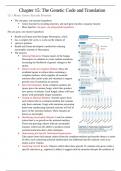Chapter 15: The Genetic Code and Translation
15.1 Many Genes Encode Proteins
The one gene, one enzyme hypothesis
Genes function by encoding enzymes, and each gene encodes a separate enzyme
More Specific: one gene, one polypeptide hypothesis
The one gene, one enzyme hypothesis
Beadle and Tatum used the fungus Neurospora, which
has a complex life cycle, to work out the relation of
genes to proteins.
Beadle and Tatum developed a method for isolating
auxotrophic mutants in Neurospora
The process:
Inducing Mutations: Expose spores of the fungus
Neurospora to radiation to create random mutations,
increasing the likelihood of genetic changes in the
spores.
Initial Growth on Complete Medium: Place the
irradiated spores in culture tubes containing a
complete medium, which supplies all essential
nutrients (like amino acids and vitamins) to support
growth, even if mutations are present.
Spore Development: In the complete medium, the
spores grow into mature fungi, which then produce
new spores via mitosis. Each fungal culture will have
spores with potentially unique mutations.
Testing on Minimal Medium: Transfer spores from
each culture tube to a minimal medium that contains
only basic nutrients. Fungi with mutations preventing
them from synthesizing essential nutrients will fail to
grow on this minimal medium. These mutants are
known as auxotrophs.
Identifying Auxotrophic Mutants: Look for cultures
where there’s no growth on the minimal medium.
These non-growing cultures indicate auxotrophic
mutants, which lack the ability to produce certain
essential molecules due to their mutations.
Determining the Specific Nutritional Requirement:
Take spores from each mutant culture (from the complete medium) and transfer them to a series
of tubes, each containing minimal medium plus one additional specific nutrient, such as an
amino acid or vitamin.
Analyzing Growth Results: Observe which tubes show growth. If a mutant only grows when a
specific nutrient (e.g., arginine) is added, it suggests that the mutation disrupts the synthesis of
, that nutrient. For instance, if growth only occurs when arginine is present, the mutation likely
affects the pathway that produces arginine in the fungus.
Method used to determine the relation between genes and enzymes in
Neurospora.
The Process:
First: isolate a series of auxotrophic mutants whose growth
required arginine
Second: test mutants for ability to grow on a minimal
medium supplemented with three compounds:
Ornithine
Citrulline
Arginine
Lastly: Place mutant into three groups based on which
substances allowed growth
The Structure and Function of Proteins
Figure 1(a) The light produced by fireflies is the result of a light-producing
reaction between luciferin and ATP catalyzed by the enzyme luciferase. (b) The
protein fibroin is the major structural component of spiderwebs. (c) Castor
beans contain a highly toxic
Proteins are
polymers consisting of amino acids linked by peptide bonds
Proteins contain 20 common amino acids, each represented by a three-letter and a one-letter
abbreviation.
, Some proteins may include modified versions of these common
amino acids.
All common amino acids share a similar structure:
Each has a central carbon atom bonded to an amino group, a
hydrogen atom, a carboxyl group, and an R group (which varies
for each amino acid).
The R groups determine the unique chemical properties of each
amino acid.
Amino acids in proteins are connected by peptide bonds, forming polypeptide chains.
A protein consists of one or more polypeptide chains.
Polypeptides have polarity under physiological conditions:
The "amino end" has a free amino group (NH3+).
The "carboxyl end" has a free carboxyl group (COO−).
Proteins are composed of 50 or more amino acids, with
some proteins containing several thousand amino acids
Amino acid sequence is the primary structure
The simplest level of protein structure, defined by the
unique linear sequence of amino acids.
This sequence is critical as it determines how the protein
will fold and function.
This structure folds to create secondary and tertiary structures
Secondary Structure
Formed when the polypeptide chain begins to fold due to hydrogen bonds between the
backbone atoms (not the side chains) of neighboring amino acids.
Two common secondary structures are:
Beta (β) Pleated Sheet: A sheet-like structure in which segments of the polypeptide
chain lie side by side, connected by hydrogen bonds.
Alpha (α) Helix: A helical structure formed by coiling the polypeptide chain,
stabilized by hydrogen bonds between the backbone atoms.
These structures add stability and define initial shape characteristics of the protein.
Tertiary Structure
The three-dimensional, overall shape of the polypeptide chain, resulting from interactions
between side chains (R groups) of amino acids.
Tertiary structure is formed by various bonds and interactions, including:
Hydrogen bonds between polar side chains.
Ionic bonds between oppositely charged side chains.
The specific folding pattern of the tertiary structure is essential for the protein’s function and
is primarily determined by the amino acid sequence (primary structure).
Two or more polypeptide chains associate to form quaternary structure
This structure arises when a protein consists of two or more polypeptide chains, known as subunits,
that interact and assemble into a functional protein complex.
The quaternary structure can involve various types of bonding and interactions, similar to those in
the tertiary structure, between the different polypeptide subunits.




